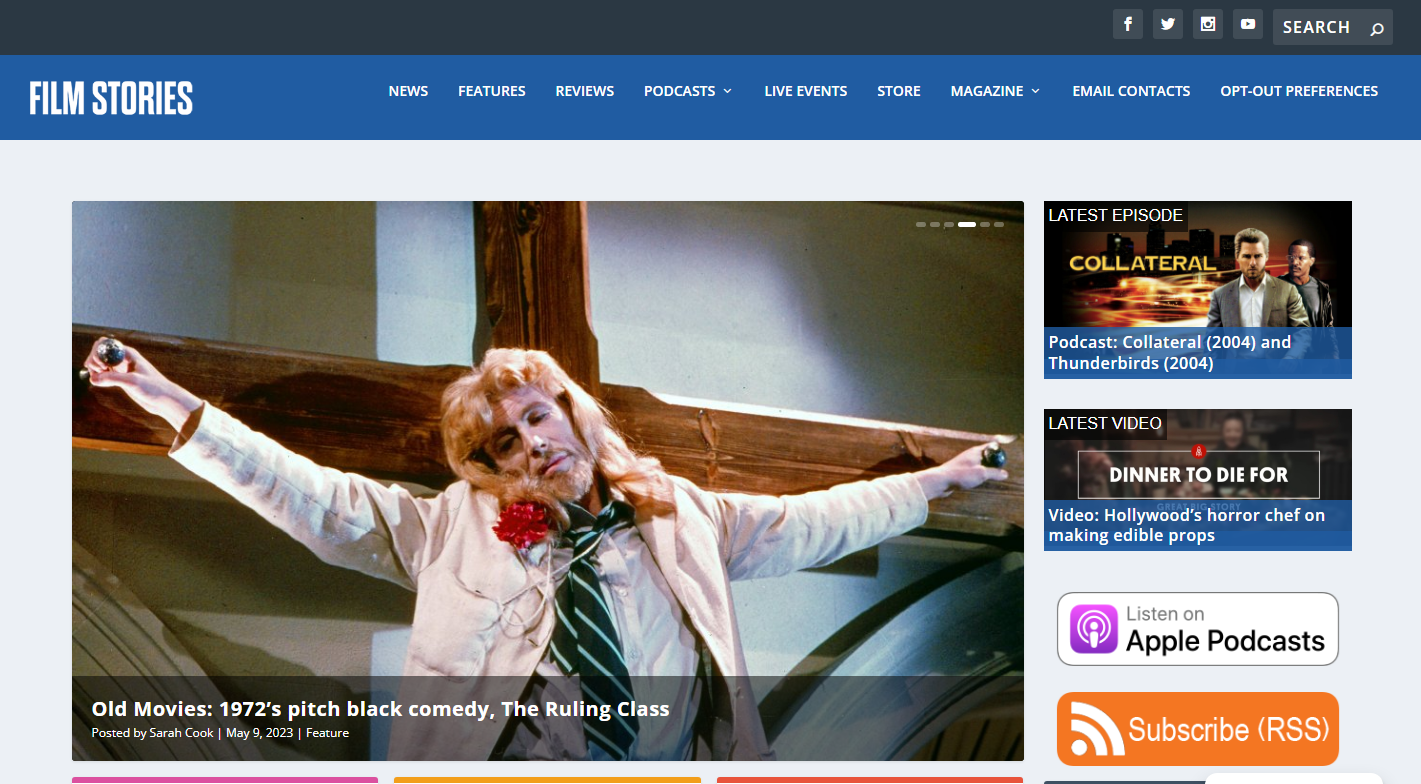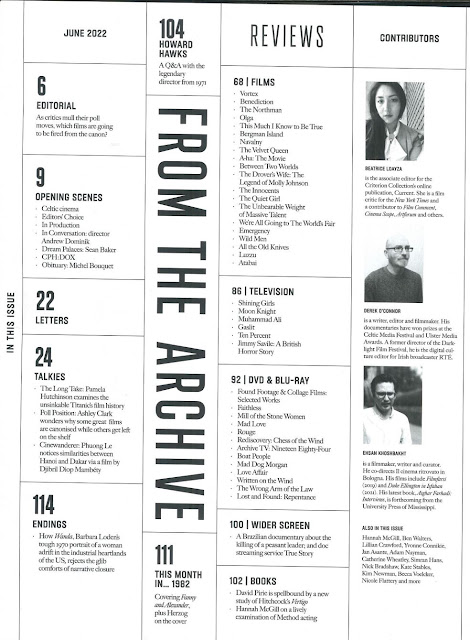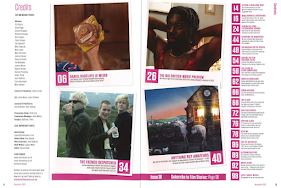This is my blog for the OCR NEA work produced by my Advanced Level Media Course.
NEA Task 12 : Research Into Film Magazine Contents Pages
NEA Task 8 : Research Into Existing Film Magazines For A Media Literate Audience
FILM STORIES
Film Stories is UK's newest film magazine and is published by Simon Brew. At first, in June 2018, it began as a podcast, as well as a website. However, in November 2018 it expanded and became a monthly film magazine. The magazine costs around £3.99 to £5.99 a copy. A typical cover features a photograph, or an illustration, of a film/show accompanied by the magazines title and issue number. The cover design could vary depending on the issue and the film/show that is being featured. The magazine has a website (filmstories.co.uk) on which you can read the news, features, reviews, podcasts, store, and also read about the magazine. Furthermore, they have contact options such as 'Email Contacts'. On their website they also feature cross media convergence as in the top right corner there are links to their other social media pages.

SIGHT AND SOUND
Sight and Sound is published by the BFI (British Film Institute) since 1932 and is published monthly. A copy of the magazine can range anywhere from £3 up to £6.30. A typical cover of Sight and Sound magazine usually features a photograph, or an illustration, related to the featured show/film. It is also usually accompanied by the magazine title right at the top of the page. The design may vary depending on the featured show/film. They don't have their own specific website but they do have a section on BFI's website which can be accessed through the ''watch and discover'' hyperlink.NEA Task 7 : My Target Audience
1. Why is target audience important to Bauer?
Target audience is important to Bauer as it helps the company understand their readers, users, listeners and advertisers. It also helps them with figuring out how to engage, inform and entertain their audience in the right way.
2. What is a media literate audience?
A media literate audience is an audience which can decode print and online media. They engage with the media and also consider the messages that may be encoded within certain texts rather than staying passive and just accepting them.
Target Audience Profile
Sam may be in the Sixth Form studying A Levels and preparations for university. If Sam is already at university they are likely to be studying at a Russell Group university and following a course that is recognised as being traditionally academic. If Sam is employed they may be at the start of their career and, therefore, not at the height of their earning potential yet.
Sam’s family background will have added significant cultural capital to their experiences. Sam will have been brought up in a household where there has been a clear focus on the importance of education and the opportunities that this can bring. Sam will have experienced holidays both in this country and abroad and their knowledge of other cultures will have been enhanced by this.
Sam is knowledgeable about current affairs but doesn’t access news via traditional channels such as newspapers or television. Sam would not dream of reading the red top or middle-market tabloids. If Sam had to, they may flick through The Guardian or i.
To keep updated on what is happening in the world Sam, like most others of their age, relies more heavily on their social media feeds. Social media is important to Sam but it doesn’t dominate their life. They are more likely to use Instagram and Tik Tok than Facebook and will be as interested in consuming as they are in producing content. Sam likes to be seen as slightly different to the average 16-25 year old and has an active interest in learning about the world around them. Sam is interested in reality television programmes such as Love Island but is likely to see it as escapist fun rather than a guide to how they should live their life.
Sam will make use of online sources such as Huffington Post, a site that features content from more than 100,000 bloggers (from politicians, students and celebrities to academics, parents and policy experts) who contribute in real-time on the subjects they are passionate about.
Sam is interested in all aspects of culture. They are interested in reading and are likely to always have at least one book by their bedside. Sam is more likely to read fiction than non-fiction and is able to hold a conversation regarding what they like and dislike in a narrative. Sam will enjoy music but doesn’t follow the crowd. Sam is interested in new music and takes pleasure in listening to artists that their friends may not have heard of yet. Sam is likely to be interested in attending festivals alongside friends.
Sam will take an active interest in film and is just as likely to stream content as visit the cinema. Sam enjoys watching Hollywood blockbusters but is just as likely to seek out the latest independent film. Sam is interested in all aspects of film-making and not just the end product and, because of this, is more likely to read film magazines such as Sight and Sound, Little White Lies and Film Stories than more mainstream magazines such as Empire and Total Film.
Sam has some disposable income but is still conscious of the need to save. Fashion is important but they are not a sheep who follows the same trends as everyone else. Sam will be seen by their friends as a trend setter and not a follower of fashion.
Sam is interested in issues that affect young people of the same age. These would include climate concerns and the impact of human beings on the environment.
NEA Task 6 : Understanding Audience (Mass Market)
1.
What is a mass market audience?
2.
What is an independent cinema?
3.
What is OnScreen magazine?
4.
What different sections are there on the OnScreen website and how do
these sections appeal to a mass market audience?
5.
How does the latest edition of OnScreen magazine (May/June 2023) appeal
to a mass market audience?
6.
What is meant by the term cross-media convergence?
7. Is there any cross-media convergence* between the magazine and its website?
OnScreen's example of cross-media convergence if their link to the website on their content page within the magazine as well as advertising the magazine on their website, on which it can be read digitally.
NEA Task 4 : Research Into An Existing Bauer Film Magazine (Empire)
The Empire magazine is known as the most successful and influential film magazine. However, not only is it just a film magazine, it also has it's own podcast, website digital edition and live events. They collaborate with some of the biggest film studios, distributors, world-class film makers and also famous actors to create content that no other brand could do: from interviewing Tom Cruise, being on set with Quentin Terantino and even to shooting videos with Ryan Reynolds!
This monthly magazine has a readership which is 75% male. Their target audience is people in the ABC bracket who are aged between 18-40 and are in employment, university educated, time-poor, in a relationship and also have a striving passion for film itself. This is quite different from our set brief; although the ABC bracket is the same, the magazine that the set brief is focusing on targets 16-25 year olds who are less likely to be in employment or university educated as most would have just began or just finished college/A-levels.
Another thing that makes this magazine so special is it's drive to creating the best content it can for it's readers. They provide exclusive insight into movie sets, for example MCU's Captain Marvel, alongside interviews with A-list celebrities such as: Olivia Coleman, Simon Pegg, Lin-Manuel Miranda and James Cameron. All of these just in the past 12 months. Many A-list celebrities want to be in this magazine.
Their digital edition is also special, they have an award-winning, enhanced with exclusive video content and pages that come to life thanks to their design team. All of this improves the experience for their audience.
They own a Top 5 Itunes podcast who has an average of 51,000 thousand hits and often includes weekly guests such as Nicole Kindman and Chris Quarrie, Their live events made it onto the news, an example being the 2018 Empire award-show.
Their advertising rates for a full page are £4,900.
NEA Task 3 : Research into the UK Magazine Industry
Following my research into the UK magazine industry, I have
discovered how big the industry is, who the biggest publishers are, the recent change
in their market share, it’s evolution throughout the years as well as it’s
predicted growth for the next foreseeable future.
The future of magazines holds an increase in demand for
creative and interactive print. This is amplified due to the diversity of
magazine titles that hold a major focus on education, entertainment,
information and other customer needs. The growth of the magazine industry all
around the world is expected to continue growing by 0.5% up to 1% yearly until
2026. A massive contributor to this stat is the contribution of smart phones
and tablet devices. The increased
availability of high-speed broadband's led to the audience being able to stream
and download content easier, thus becoming more popular. Due to this, various
publishers have been creating content in digital formats specifically for easy
access for mobile users with the hopes of improving customer engagement as well
as bringing in a wider audience.
Publishers are finding innovative ways to increase their customers’
interactions and the reliability of magazines overall. This includes attracting
the attention of more readers to their websites through campaign-specific links
and interactive printed adverts followed by building awareness. Whilst doing
so, they’re also increasing customer engagement. An example of this would be GQ
France, who launched a mobile app to improve the digital experience for its
subscribers, it offers content from the printed magazine and also some
exclusive content for style, food, fashion and well-being. It also offers
additional masterclasses, podcasts and weekly competitions. Each month 76% of
adults have been reached by UK magazine media.
Some of the top advertisers for magazines are Sainsbury’s,
Johnson & Johnson, Apple, Channel and VictoriaPlum. 63% of adults access to
read through a digital format, and this stat is growing continuously. 72% of
readers see it as a time well spent and 91% believe that what they read is
trustworthy.
Press Gazette has analysed data from the past two decades on
how the UK consumer magazine industry has changed, simultaneously revealing how
the sector is being reshaped. Magazines have been hit by sharp falls in
advertising revenue, which have fallen by 33% from 2019 to 2020 and has still
not recovered. However, digital revenues have been on the rise, but
unfortunately are still yet to compensate for the decline. Furthermore, the
total circulation of magazines has also been on the decline, falling from 1.6
billion in 2000 to 565 million in last year. This means consumer expenditure
also shrunk down to 669 million in 2020 compared with 1.4 billion in 2000. This
sharp fall in spending has lead to a large amount of UK magazines closing.
The ownership of the UK magazine industry is still quite
diverse compared to newspapers. The leading companies include Bauer Media,
Immediate Media Company and Future Plc, who own around 37% of circulation in
2020. The three major publishers who hold the most market share are IT Media,
Bauer and BBC who have been responsible for 42% of all magazine copies that
have circulated, which is a small increase compared to 41% in leading publishers
back in 2000. The single-biggest company is Mark Allen, who accounted for 12%
of B2B magazine circulation in 2020.
NEA Task 2: Research into Bauer
Bauer Media
Group goal is to inform and entertain millions and people and is one of the world’s
most successful companies. The private-owned company was founded in 1875 by
Heinz Bauer and is located in Hamburg, Germany but it also operated within twenty
countries around the world. They own two very high-performance printing plants
in Wykroty and Ciechanow, both of which produce over fifty regular magazines
which are sold across Europe. They have over 140+ years of publishing
experience and currently, Bauer is owned by Yvonne Bauer, Heinz Bauer’s granddaughter.
Bauer Media specializes in creating various of different products, which are
usually targeted towards women, teens or even young adults. Some examples are
magazines, digital formats and even radio across Europe. They own over six hundred
magazines (and are actually one of the largest magazine publishers in Europe), four
hundred digital products and fifty radio/tv stations. Some of their more
popular titles include Grazia, Cosmopolitan and Heat. Over four hundred titles
and over one hundred digital products have all been made to entertain, inform,
and inspire audiences of all ages. Bauer aims to provide their users with expert
content, engaging experiences and also appropriate help to help them get the
absolute most out of their passions as well as interests in hopes of fulfilling
their needs.
Not only
have they been successful with magazines, digital formats and radio, but they
also own a large event business. They produce a large variety of live events as
well as concerts such as Coldplay.
NEA Task 1: Introduction to Set Brief
Requirements of the brief
You work for an independent media production company.
You have been given the task of producing the front cover and contents page(s) of the first two editions of a new film magazine that is being launched by Bauer and two pages for the working website for the magazine.
Contents pages can be either single or double page spread.
The web pages must promote the new magazine to its target audience and enable fans to interact with the content.
Summary of brief requirements:
• Statement of Intent (approx. 500 words) : to be completed after research phase of NEA.
• Magazine covers and contents pages: Two or three pages for each of the first two editions (based on choice of single or double page spread).
• Magazine distribution method: Content must be suitable for retail distribution.
• Number of web pages: One homepage and one linked page.
• Cross media production target audience: A primarily 16–25-year-old middle and upmarket media literate audience.
There must be a clear sense of branding across the two elements of the cross-media production.
NEA Rules
The following rules MUST be adhered to:
- Do not reproduce an existing media product.
- Group productions are not allowed. Others may act in or appear in the production and/or may operate lighting, sound, recording or other equipment under your direction.
- You MUST only use original footage, images and/or text within your production.
- You MUST NOT use any found images.
Completed NEA
Dear Moderator, My name is Kamilla-Zasmin Bilaniva. Welcome to my A Level Media Studies blog. This is a record of the work I have undertake...

-
1. What is a mass market audience? A mass market audience is a large group of consumers who share common preferences for a specif...
-
1. Why is target audience important to Bauer? Target audience is important to Bauer as it helps the company understand their readers, user...
-
Dear Moderator, My name is Kamilla-Zasmin Bilaniva. Welcome to my A Level Media Studies blog. This is a record of the work I have undertake...

























